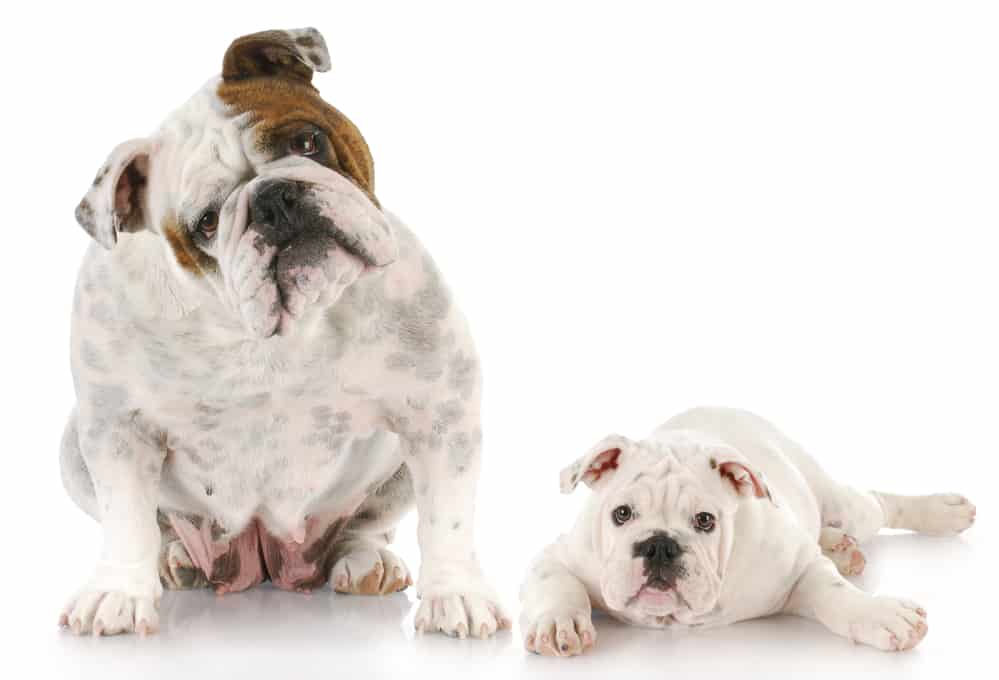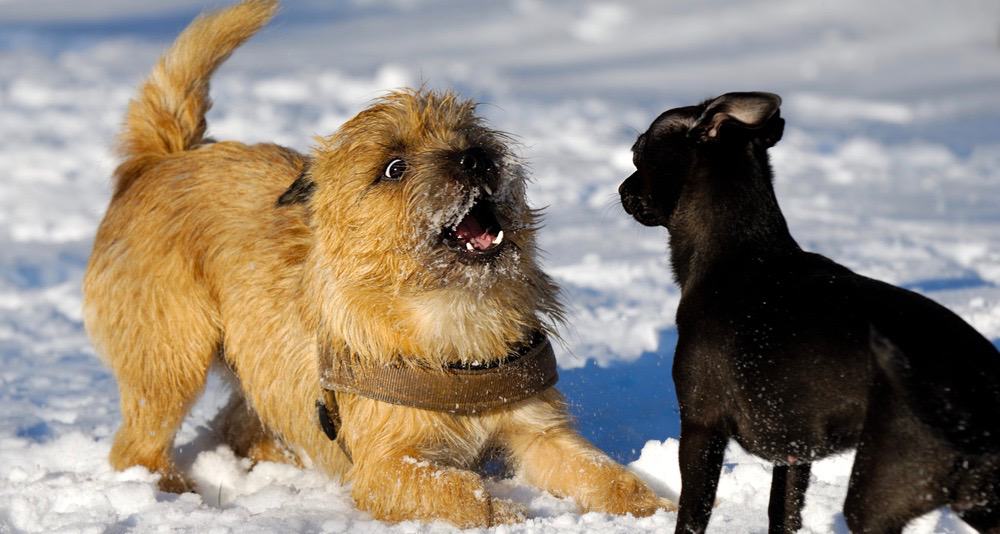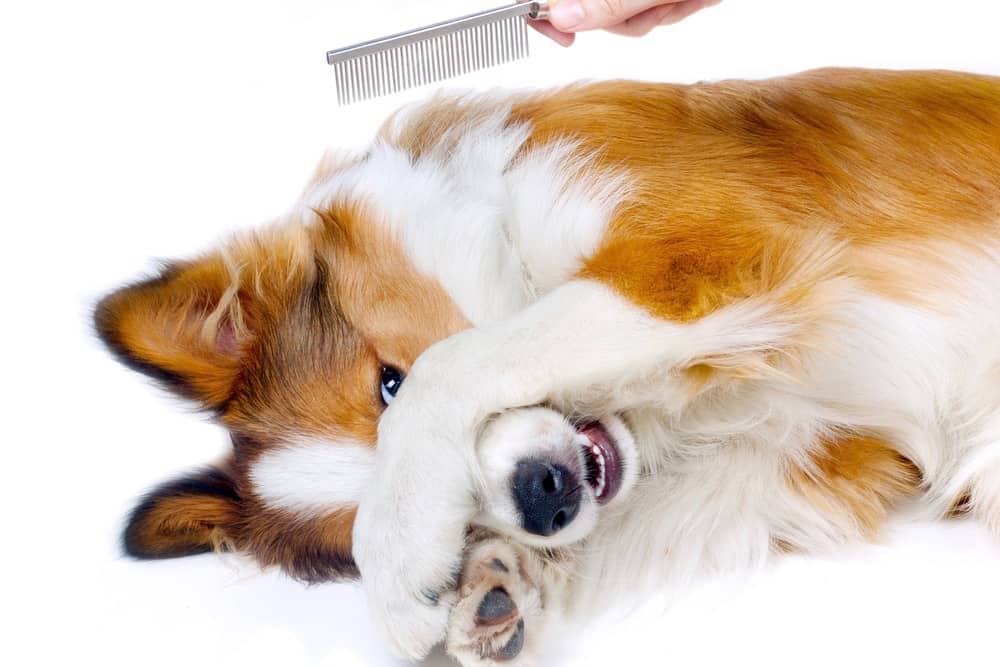Dog Ear Positions Chart – What Does Your Dog’s Ear Position Mean?
It is incredibly adorable to watch your dog move his ears all around as if he is picking up a satellite signal. But to know what the movement might actually mean, you need to consult with a dog ear positions chart.
Using the chart, you will be able to decode the movement of your dog in terms of his ears, his eyes, and even his tail wagging.
All of a dog’s body language can be interpreted to help you work out what your dog might be feeling.
Dog Ear Position Meaning

Neutral Position
When starting to look at what your dog’s ears are trying to tell you, the first thing to know is what they look like when they are neutral.
A neutral position is just the default placement of a dog’s ears. Some dogs have ears that hang straight down when neutral and other dogs have ears that stand up.
When you know what the neutral position is, you will be able to know how the ears shift when showing other emotions. Different breeds also move their ears around differently, so it is something to keep in mind.
Attentive & Pricked Ears
This position is when the ears are lifted up and facing forward, but not in an alarmed manner. A dog is most likely to use this position when they are in the middle of play with another dog. It is a way of showing excitement, enthusiasm, and playfulness.
If you make a silly sound or speak to your dog, sometimes they will manoeuvre their ears as if they are listening and trying to break down exactly what you are saying.
This position can easily be confused with the alert position, and in some dogs, the two positions will look the same and you will need to rely on other body language for more information.

Alert & Concerned Ears
Your dog’s ears will definitely tell you when he is on alert. This is when a dog will prick his ears upward as if they are listening to something more closely.
It can also happen if the dog hears something that he cannot recognize or something that is out of the ordinary for your living space.
A dog might use the same ear movement when he is completely immersed in playing and giving it his whole attention.
It would be best to eliminate whatever is getting the dog’s attention. Depending on what it is, you might allow your dog in the yard, or distract him with a treat.
Dropped Back Ears
The dropped-back ear look is generally a friendly position. It is more of a way that your dog is asking whether you would like to play, take him outside, or might even be his way of telling you that it is dinner time.
If he is wagging his tail at the same time, it is a safe bet that your dog just wants you to play with him. Some dogs use this position as a simple way of getting you to pet them, placing their head on your knee, and looking up at you.

Extremely Pinned Ears
When a dog moves its ears all of the ways back and drops them low, there is a good chance that your dog is seriously scared of something that is happening around him.
When they are only back slightly, it is more of a guilt or sign of submission, so when they are severely back, it means that the dog feels that he is in danger.
You need to be on guard if your dog moves his ears back like this because he can easily move into fight or flight mode. The best thing to do in this situation is to get your dog away from whatever he’s threatened by.
Ears Changing Positions
You might have noticed that dogs have a strong tendency to move their ears about, but if they are moving their ear position around pretty quickly, it means the dogs are a little bit confused.
In this situation, you will have an impossible time trying to identify a dog’s emotions. That’s ok because it also means that your dog cannot identify how he’s feeling either.
When he is moving his ears like that, there is a good chance that he cannot work out what he is hearing or sensing. It might be good to help your dog figure it out.
Pointed Ears
You might notice this behavior in your dog when it feels threatened. When your dog’s ears are in a Pointed position, it could be letting other dogs know that it is in defense mode.
This is the time for you to separate your dog from whatever it is feeling threatened by.
Dog Ear Positions Chart
| Dog Ear Position | Meaning |
|---|---|
| Neutral Position | Your dog is relaxed |
| Attentive & Pricked Ears | Your dog is excited and wants to play |
| Alert & Concerned Ears | Your dog is on alert |
| Dropped Back Ears | Your dog wants to play or go for a walk |
| Extremely Pinned Ears | Your dog is scared |
| Ears Changing Positions | Your dog is confused |
Other Dog Body Language Meaning

Eyes
While the ears are the best way of determining what your dog is thinking or feeling, it is not the only way. You can also use a dog’s eyes to get a better idea of a dog’s mood.
When a dog is looking at you softly and directly, you know that the dog is friendly. A harder stare could tell you different things like whether the dog is excited, upset, or even angry.
If the dog is blinking a lot and the pupils seem to be dilated, the dog might be stressed out. Finally, if a dog will not look at you, chances are good that he is scared.
Dog Posture
Body language is a big indicator of mood in humans and can also be a big indicator in dogs. Your dog’s body posture can tell you a lot about how he is feeling.
A dog that stands straight is usually relaxed and can be approached. A dog that is shifting his weight to be more over his front legs might be feeling upset. It could also be ready to pounce.
Also, a dog that has his body hunched down with his back curved upward is likely a dog that is very afraid. The position that you should hope to see in a puppy is a puppy play stance.
A dog will lie down on his front legs, sticking his haunches in the air. This is how he signals other dogs that it’s playtime.
Finally, if your dog has rolled over on his back he is either asking for a scratch or is showing his surrender.

Dog Gestures
It is a little bit of a funny thought, but dogs will also make gestures that can give you an idea of how they are feeling. It is almost like your dog is speaking sign language.
One common gesture is a raised paw that is used to touch a human or another dog. It usually is an indication that the dog needs something, which might be as simple as attention.
Another common gesture is when a dog has his ears up and head tilted as if he is trying to work out everything that you are saying or doing.
Face Expressions
Did you know that dogs have facial expressions too? A dog’s face can tell you a lot about how he is feeling. A dog with a wide-open mouth usually means the dog is happy, almost like he is smiling.
On the other end of things, you have bared front teeth. When a dog shows off his canines he is being aggressive. Some dogs do this as part of their play, but if you don’t know this ahead of time, it is best to steer clear of the dog until he calms down.
Tail
When people think about a dog’s wagging tail, the first thing that comes to mind is that the dog is happy. A happy dog wags his tail, right?
But tail wagging can be more complicated than that. It is true that tail wagging often means that the dog is happy, it could mean other things as well.
In truth, tail wagging is just an indication of the emotion of some variety. The position that your dog is holding his tail while he is wagging means something.
If the tail is held high and wagging stiffly, it might be a sign of aggression rather than happiness.
Do not pet a dog with a wagging tail if you do not know the dog. It is an easy way to get a dog bite. Likewise, a low wag with the ears down means the dog is scared and might also bite you.
Barking
Clearly, your dog cannot talk to you and just tell you what he is thinking or feeling. It will convey much of what he has to say with his body, he might also convey his feelings with his voice.
Other forms of vocalization might include growling and whining, but all of them mean something when used.
Different sizes of dogs will have very different barks and as your dog’s owner, you will be able to determine the different pitches of the barks to interpret your dog’s message.
Dog Breeds
It’s important to understand that not all dog breeds can move their ears to every position. Understand that the ear position doesn’t always tell the whole story.
Some breeds pointed ears so their resting position will be different from those with floppy ears. Dogs like Beagles have folded ears so their ear positions will look different from Chihuahua’s.
Frequently Asked Question’s
What do the different “Ear Positions” of dogs mean?
Different ear positions in dogs have specific meanings:
- Erect or Pointed Ears: indicate alertness and attentiveness.
- Relaxed or Neutral Ears: signify a calm and content state.
- Folded or Backward Ears: indicate submission or fear.
- Half-Raised or Semi-Pricked Ears: indicate curiosity or mild interest.
- Flattened or Pinned-Back Ears: indicate fear, submission, or aggression.
It’s important to consider other body language cues for a more accurate understanding of a dog’s emotions.
Why Do Dogs Put Their Ears Back When They Are Happy?
Dogs put their ears back when they are happy as a sign of contentment and relaxation, expressing trust and seeking affection.
What Does “Airplane Ears” on Dogs Mean?
Dogs that have their ears out to the sides, often known as “airplane ears,” typically show these characteristics when they are alert, curious, or paying close attention to their environment. They can easily capture noises with this ear posture, which helps them learn about their surroundings. It is noticeable when a dog is paying attention intensively, listening carefully, or evaluating a situation.
Why Do Dogs Put One Ear Down?
Dogs may droop one ear for a number of reasons. The dog may be displaying a relaxed or submissive stance, for example, which is a typical reason. This ear position could represent a passive or non-aggressive posture. Dogs may also droop one ear when they are uneasy, nervous, or seeking to convey their lack of confidence. To fully understand the exact meaning behind a dog’s ear position, it is important to take into consideration other body language signs as well as the context.
Final Words
Once you have been a dog parent for a while, it will be much easier to identify your dog’s body language and all that it means.
Regardless of how well you know your own dog, it is still a good idea to understand the dog ear positions chart, in order to prevent dangerous situations and to ensure that you have a positive interaction.
Since your dog cannot tell you when he is happy, scared, or upset. It’s a good idea to key into your dog’s emotions and knows everything that he is feeling. That way, you can have a nice, harmonious relationship.






